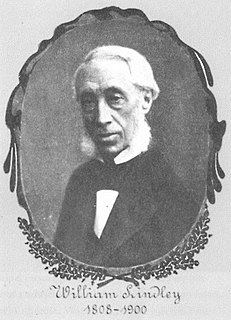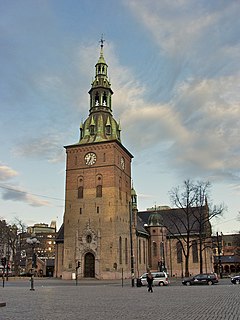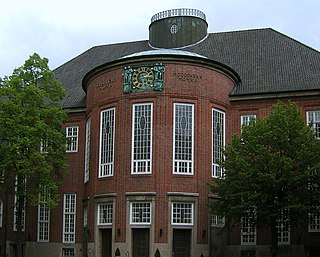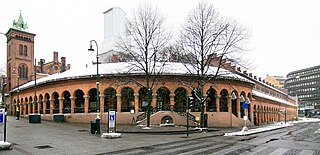Alexis de Chateauneuf | |
|---|---|
 | |
| Born | 18 February 1799 |
| Died | 31 December 1853 (aged 54) Hamburg |
| Occupation | architect |
Alexis de Chateauneuf (1799 - 1853) was a German architect and city planner from Hamburg. [1]
Alexis de Chateauneuf | |
|---|---|
 | |
| Born | 18 February 1799 |
| Died | 31 December 1853 (aged 54) Hamburg |
| Occupation | architect |
Alexis de Chateauneuf (1799 - 1853) was a German architect and city planner from Hamburg. [1]
Chateauneuf was a son of French emigrants. He was educated in Hamburg, Paris and Karlsruhe, as well as a short stay at Karl Friedrich Schinkel in Berlin. Chateauneuf played a particularly prominent role during the reconstruction of Hamburg after the city fire in 1842. He also worked in London (1839-1840) and Christiania (Oslo) (1847-1850).
Alexis de Chateauneuf is considered one of the pioneers in the renovation of brick architecture in Hamburg. Several of the buildings he constructed in Hamburg had exposed bricks in the façades, which was publicly discussed. At this time it was common for brick to be covered with gypsum or cement. He made proposals for changes to existing buildings, new buildings and was active in a number of architectural competitions. Many of his proposals were completed. In the district of Neustadt in Hamburg, became a remarkable residential building completed after his drawings. He then received several assignments for both private individuals and for public buildings. He participated in several architectural competitions on stock exchange buildings, first the Hamburg Stock Exchange, later London Stock Exchange (1840). He did not win any of these competitions, but took second place in the architectural competition on the London Stock Exchange. [2] [3]

After the Great fire of Hamburg in 1842, he created several buildings, such as the Alsterarkaden building complex and St Peter's Church in Hamburg. He also contributed to the urban planning in general, and 1842-1847 he was chairman of the technical commission appointed to draw up plans for rebuilding the city. [1] [3]
Alexis de Chateauneuf married Caspara Møller from the then Christiania, Norway in 1846. In connection with a family visit in the city, he presented the drafts that led to the rebuilding of Vår Frelser's church - now the Oslo Cathedral. Chateauneuf delivered his own draft and the cathedral was reconstructed after this. Heinrich Ernst Schirmer was employed as a construction manager and Chateauneuf signed a contract.
At the same time, the authorities had initiated the planning of a new church in the city, which would be the Trinity Church (Oslo). Chateauneuf won the architectural competition. However, he died in 1853 before the cathedral was finished and his former student, Wilhelm von Hanno, completed the project. [1]

Les Invalides, formally the Hôtel national des Invalides, also Hôtel des Invalides is a complex of buildings in the 7th arrondissement of Paris, France, containing museums and monuments, all relating to the military history of France, as well as a hospital and a retirement home for war veterans, the buildings’ original purpose. The buildings house the Musée de l'Armée, the military museum of the Army of France, the Musée des Plans-Reliefs, and the Musée d'Histoire Contemporaine. The complex also includes the former hospital chapel, now national cathedral of the French military, and the adjacent former Royal Chapel known as the Dôme des Invalides, the tallest church building in Paris at a height of 107 meters. The latter has been converted into a shrine of some of France's leading military figures, most notably the tomb of Napoleon.

Johan Henrik Nebelong was a Danish architect. He worked in Norway from 1840 to 1853 and was best known for interior design work on Oscarshall (1847–1852). Nebelong also taught at the Royal Academy of Arts in Copenhagen.
The year 1858 in architecture involved some significant events.

William Lindley, was an English engineer who together with his sons designed water and sewerage systems for over 30 cities across Europe.

Oslo Cathedral — formerly Our Savior's Church — is the main church for the Church of Norway Diocese of Oslo, as well as the parish church for downtown Oslo. The present building dates from 1694–1697.

Heinrich Ernst Schirmer was a German-born architect most noted for his work in Norway. Schirmer worked in Norway from 1838 to 1883 and left his mark on a number of public buildings. He contributed significantly to the introduction of the so-called Swiss architectural style in Norway, based partly on Italian villa style, Gothic Revival, and neoclassicism.

The architecture of Norway has evolved in response to changing economic conditions, technological advances, demographic fluctuations and cultural shifts. While outside architectural influences are apparent in much of Norwegian architecture, they have often been adapted to meet Norwegian climatic conditions, including: harsh winters, high winds and, in coastal areas, salt spray.

Christian Heinrich Grosch was a Norwegian architect. He was a dominant figure in Norwegian architecture in the first half of the 1800s.

The Church of St. Nicholas was a Gothic Revival cathedral that was formerly one of the five Lutheran Hauptkirchen in the city of Hamburg, Germany. The original chapel, a wooden building, was completed in 1195. It was replaced by a brick church in the 14th century, which was eventually destroyed by fire in 1842. The church was completely rebuilt by 1874, and was the tallest building in the world from 1874 to 1876. It was designed by the English architect George Gilbert Scott.

Georg Christian Sibbern was a Norwegian diplomat who served as the prime minister of Norway.

The architecture of Denmark has its origins in the Viking period, richly revealed by archaeological finds. It became firmly established in the Middle Ages when first Romanesque, then Gothic churches and cathedrals sprang up throughout the country. It was during this period that, in a country with little access to stone, brick became the construction material of choice, not just for churches but also for fortifications and castles.

Karl Marius Anton Johan Hals was a Norwegian businessperson who co-founded the piano manufacturer Brødrene Hals. He also served as a members of the Norwegian Parliament with the Conservative Party.

Andreas Friedrich Wilhelm von Hanno was a German-born Norwegian architect, sculptor and painter. He was among the leading architects in Norway during the middle of the 1800s.

The Gelehrtenschule des Johanneums is a Gymnasium in Hamburg, Germany. It is Hamburg's oldest school and was founded in 1529 by Johannes Bugenhagen. The school's focus is on the teaching of Latin and ancient Greek. It is proud of having educated some of Germany's political leaders as well as some of Germany's notable scientists. The school is operated and financed by the city of Hamburg.

Ludvig Kristensen Daa was a Norwegian historian, ethnologist, auditor, editor of magazines and newspapers, educator and politician.

Oslo Bazaars are located at Oslo Cathedral, along the streets Karl Johans gate and Dronningens gate in Oslo, Norway. The buildings of the bazaar constitute a continuous facility that encircles three sides of the quarter with Oslo Cathedral.

Trinity Church, is a church in the Hammersborg neighborhood in central Oslo, Norway. Trinity Church is neighbor of the government buildings in Regjeringskvartalet. It is the parish church of the parish of Trinity, belonging to the Diocese of Oslo of the Church of Norway. It is one of the largest churches in Oslo. The church itself is in the raw red brick, while the vaults, arches and small columns have gray scale color. The nave is octagonal with a Greek cross superimposed, with the choir in the apse, shallow transept and rectangular entrance flanked by two slender, octagonal bell towers. A central dome rises above the church. Trinity Church is the largest church in Oslo and one of the largest of the many octagonal churches in Norway, but one of few octagonal churches constructed in red brick.

Neustadt is one of the inner-city districts of the Free and Hanseatic City of Hamburg, Germany.

Ole Peter Riis Høegh was one of Norway's first trained civilian architects and was Bergen's first town surveyor.

Theodor Bülau was a German architect.